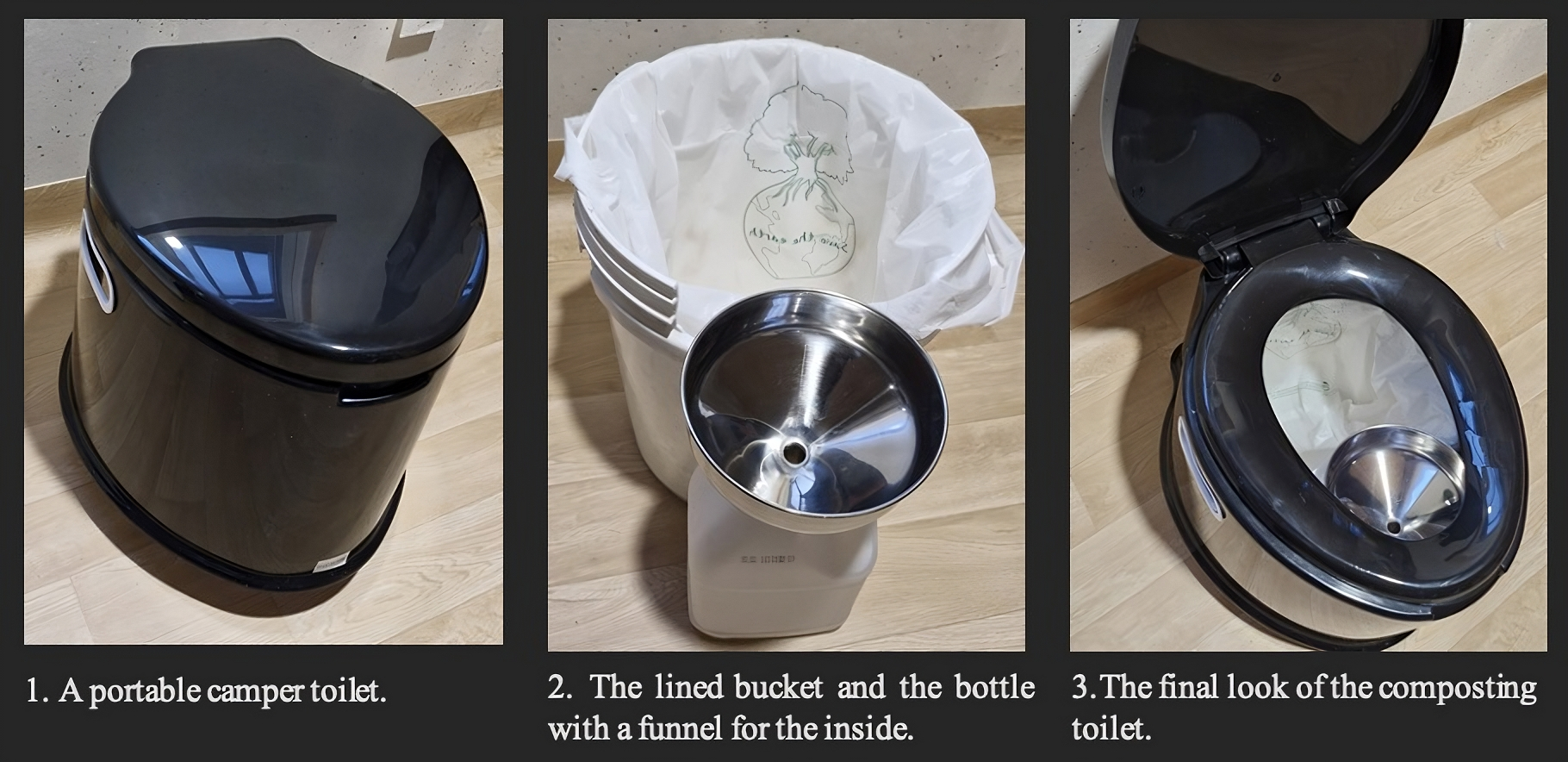Composting Toilets: Nature Calls – January 2025
By Chung Hyunhwa
For campers or people who wish to be off- grid, one thing to consider is the type of toilet you will be using. Normally in the city, homes are connected to the public sewer system or a septic tank buried in the ground. In a remote area, a septic tank is the option chosen most often, but it always releases some polluted water into the surroundings if a sewer pipe is not available nearby. To avoid that, I started searching for other options and found that there are a number of independent off-grid toilets.
One type I found was a biodegradable toilet. It is great in the way that it is the same as an ordinary flush toilet, but its underground circulation system with specific bacteria decomposes the waste flushed with water and leaves water that is clean enough to be used in the toilet again.
Because the system is quite expensive, it is more suitable for public toilets at parks and in the mountains. I remember seeing one installed along the highway.
Another type that I found online was an independent toilet unit. You can place this toilet unit anywhere outside that you like. It comes as a minimal flush toilet with a tiny sink to wash one’s hands as part of the unit. However, the tank at the bottom should be emptied occasionally, so you have to call the septic tank cleaning service. This is more suited for several people working at a remote farming area, since the septic tank is not very big.
One of the latest, and surprising, off-grid toilets was an incinerating toilet. It burns waste after every use. It sounds like it does its job. However, each process takes 90 minutes, and I thought it is reasonable only if it is run by its own solar panels.
Then, I found the most reasonable, practical, and most environment-friendly option: a composting toilet. In our history, human manure was used throughout the world, although it’s not so often used nowadays. I searched more to find that these composting toilets are most often found in the U.S., as some toilets just have to be off- grid because it is such a vast country. Also, some homes install them indoors just like a normal flush toilet.
The basic structure of a composting toilet is about the same despite their variety in design. Underneath the toilet seat, there is a urine separator that is connected to a bottle or other container directly or by a hose, and there is a bucket for the solid waste. To avoid creating a strong smell, it is advised that the urine be collected separately. Another secret to removing the odor is carbon-based materials such as sawdust, dried leaves, or grain husks used to cover the waste material. The covering material is stored in a separate container, very close to the toilet, so you can scoop out some of this material for covering after each toilet use. The carbon- based materials absorb humidity, too, so the inside of the bucket remains dry, storing the feces without decaying quickly and creating odor.
Commercial composting toilets are being sold for between 500 and 2,000 US dollars. It sounds pricey, but it is still cheaper and easier than installing a septic tank. Also, you can do one yourself at a very low cost. You can use wood for the frame building, but you can also use an inexpensive portable camper toilet as an easy option. If you merely place a bucket and a bottle for urine inside the portable toilet, your compost toilet is finished! Instead of a urine separator, you can use a funnel. Bio-degradable plastic bags can be put into the bucket for easy use, but it is really not necessary since it is easy to empty and clean the bucket because the covering materials keep the inside dry. The urine can be used in two weeks for garden plants after being diluted in water for
its nitrogen, phosphorus, potassium, and trace elements. The feces mixed with the covering material can become compost after fermentation with a good amount of humidity and a period of time.
Do you know that during the composting process, the temperature can rise to over 80°C? This way, surprisingly, the end product is actually very clean. I once experienced using a composting toilet on a blueberry farm and remember it being surprisingly pleasant with no odor. The farm was very well organized and known for its tasty organic blueberries. I assume the composting toilet also contributed to the farm’s famous blueberries.
A person uses the toilet on average seven times a day, and uses nine liters of water with each flush, which adds up to 63 liters a day and 22,996 liters a year. Even with the latest toilet models that may reportedly use 3.5 liters each flush, it will still add up to about 25 liters a day and 8,943 liters a year. That is a lot of water, and a lot of energy because the water supply system uses electricity. From this search, I was happy to discover this information about composting toilets, the least disruptive toilet to nature. We live on this globe for a period of time; it is like borrowing it for that time. Then, we have to pass the globe on to the next generation. To have that sustainability, we need to return what we borrowed from Mother Nature as intact as possible. “Leave No Trace” must be the best policy for the next generation to appreciate what we leave behind.
Photographs by Chung Hyunhwa.
The Author
Chung Hyunhwa, a native of Gwangju, currently works for a horticultural company. She led the international eco-hike group Gwangju Hikers at the GIC in 2020 and 2021. Previously, she taught English at Yantai American School and Yantai Korean School in China and worked in school administration at Branksome Hall Asia in Jeju. She holds a master’s degree in TESOL from TCNJ in the U.S. and a license to teach Korean. She loves plants, birds, and repurposing items creatively.



